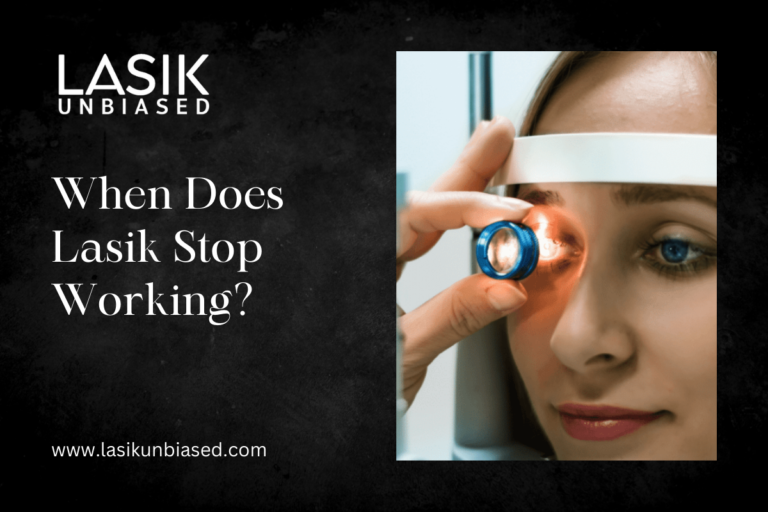LASIK is a highly compelling vision correction procedure that permanently reshapes the cornea to improve vision. Most patients enjoy clear vision for years or even decades after surgery. However, LASIK does not stop the natural ageing process of the eyes.
Some people may experience vision changes over time, making them wonder whether LASIK has “stopped working.” Understanding the factors influencing long-term LASIK results helps patients set realistic expectations and take appropriate steps to maintain their vision.
Does LASIK Provide Permanent Vision Correction?
LASIK permanently corrects refractive errors such as nearsightedness (myopia), farsightedness (hyperopia), and astigmatism by reshaping the cornea. The changes made to the cornea do not reverse, meaning the correction itself is permanent. However, other factors can affect vision over time, making it seem like LASIK has stopped working. These factors include natural ageing, eye health conditions, and lifestyle habits.
Common Reasons for Vision Changes After LASIK
Presbyopia: Age-Related Near Vision Loss
One of the most common reasons people experience vision changes after LASIK is presbyopia, a natural age-related condition that affects near vision. It typically begins around the age of 40 and occurs when the eye’s natural lens loses flexibility, making it harder to focus on close objects.
Since LASIK reshapes the cornea but does not change the lens, it does not prevent presbyopia. Many people with LASIK in their 20s or 30s may need reading glasses later. Some patients choose monovision LASIK, which corrects one eye for distance vision and the other for near vision, to manage presbyopia.
Regression: Minor Vision Changes Over Time
In some cases, a slight regression of vision may occur years after LASIK. This means the eye’s refractive error slowly returns to a mild degree, making vision slightly less sharp than immediately after surgery. Regression is more common in people who had high prescriptions before LASIK, as their corneas may be more prone to subtle changes over time.
Regression does not mean LASIK has failed, but it may require a minor enhancement procedure to restore optimal clarity. Many LASIK providers offer enhancement treatments if necessary, especially within the first few years after the initial surgery.
Cataracts: Clouding of the Eye’s Natural Lens
Cataracts are another age-related condition that can impact vision after LASIK. They develop when the eye’s natural lens becomes cloudy, leading to blurred vision, glare, and difficulty seeing in low light. Although this condition is unrelated to LASIK, it can make it seem as though it is no longer effective.
When cataracts develop, the best solution is cataract surgery, which replaces the cloudy lens with an artificial intraocular lens (IOL). Patients who previously had LASIK should inform their cataract surgeons so that appropriate lens power calculations can be made for the best visual outcome.
Changes in the Cornea Due to Eye Conditions
Certain eye conditions can affect the cornea, leading to vision changes even after LASIK. These include:
- Keratoconus: A progressive cornea thinning that can lead to irregular astigmatism.
- Epithelial Ingrowth: A rare condition where surface cells grow under the LASIK flap, affecting vision clarity.
- Dry Eye Syndrome: Chronic dryness can cause fluctuating vision and discomfort, making it seem like LASIK results are fading.
Regular eye exams help detect these conditions early so that appropriate treatment can be provided.
Myopia Progression in Younger Patients
For LASIK to provide long-lasting results, the patient’s prescription should be stable before surgery. Younger individuals, especially those under 20, may still experience changes in their vision if their myopia (nearsightedness) continues to progress. If LASIK is performed too early, the eyes may change, necessitating additional vision correction.
This is why most LASIK surgeons require patients to have a stable prescription for at least one to two years before surgery.
Lifestyle Factors That Affect Vision
Certain lifestyle habits can contribute to vision changes after LASIK. Excessive screen time, prolonged exposure to blue light, and inadequate eye care may lead to eye strain and temporary vision fluctuations. Maintaining sound eye health using protective eyewear, taking screen breaks, and staying hydrated can help preserve visual clarity.
Can LASIK Results Be Restored?
If vision changes occur after LASIK, several options exist to improve clarity. The appropriate solution depends on the cause of the vision change.
LASIK Enhancements
A LASIK enhancement procedure can fine-tune vision for patients who experience mild regression. This is a quick and effective way to restore clarity, especially if the cornea has enough remaining thickness to allow for additional reshaping. If needed, most enhancements are performed within five to ten years of the initial LASIK procedure.
Monovision LASIK for Presbyopia
For individuals experiencing presbyopia, monovision LASIK may be an option. This technique corrects one eye for distance vision and the other for near vision, reducing dependence on reading glasses. However, not everyone adapts well to monovision, so a trial with contact lenses is often recommended before the procedure.
Refractive Lens Exchange (RLE)
Refractive lens exchange (RLE) is another option for patients with presbyopia or early cataracts. This procedure replaces the eye’s natural lens with an artificial intraocular lens (IOL), providing clear vision at multiple distances. It is similar to cataract surgery and can be a good alternative for individuals whose vision changes significantly after LASIK.
Cataract Surgery for Age-Related Vision Loss
If cataracts are the reason for vision decline, cataract surgery is the best solution. The procedure involves removing the cloudy natural lens and replacing it with an artificial lens, restoring clear vision. Patients with a history of LASIK should consult an experienced cataract surgeon to ensure accurate lens selection.
How to Maintain Clear Vision After LASIK
Although LASIK provides long-term vision correction, maintaining eye health is essential for preserving clear vision. Here are some ways to maintain good vision after LASIK:
- Schedule Regular Eye Exams: Routine check-ups help detect early vision changes and ensure overall eye health.
- Wear UV-Protective Sunglasses: Protecting the eyes from UV damage helps prevent cataracts and other vision problems.
- Use Artificial Tears if Needed: Lubricating eye drops reduces dryness and irritation, especially for those who spend long hours on digital screens.
- Practice Healthy Screen Habits: Taking breaks from screens and using blue light filters can help reduce digital eye strain.
- Avoid Eye Trauma: Protective eyewear during sports or hazardous activities prevents accidental eye damage.


